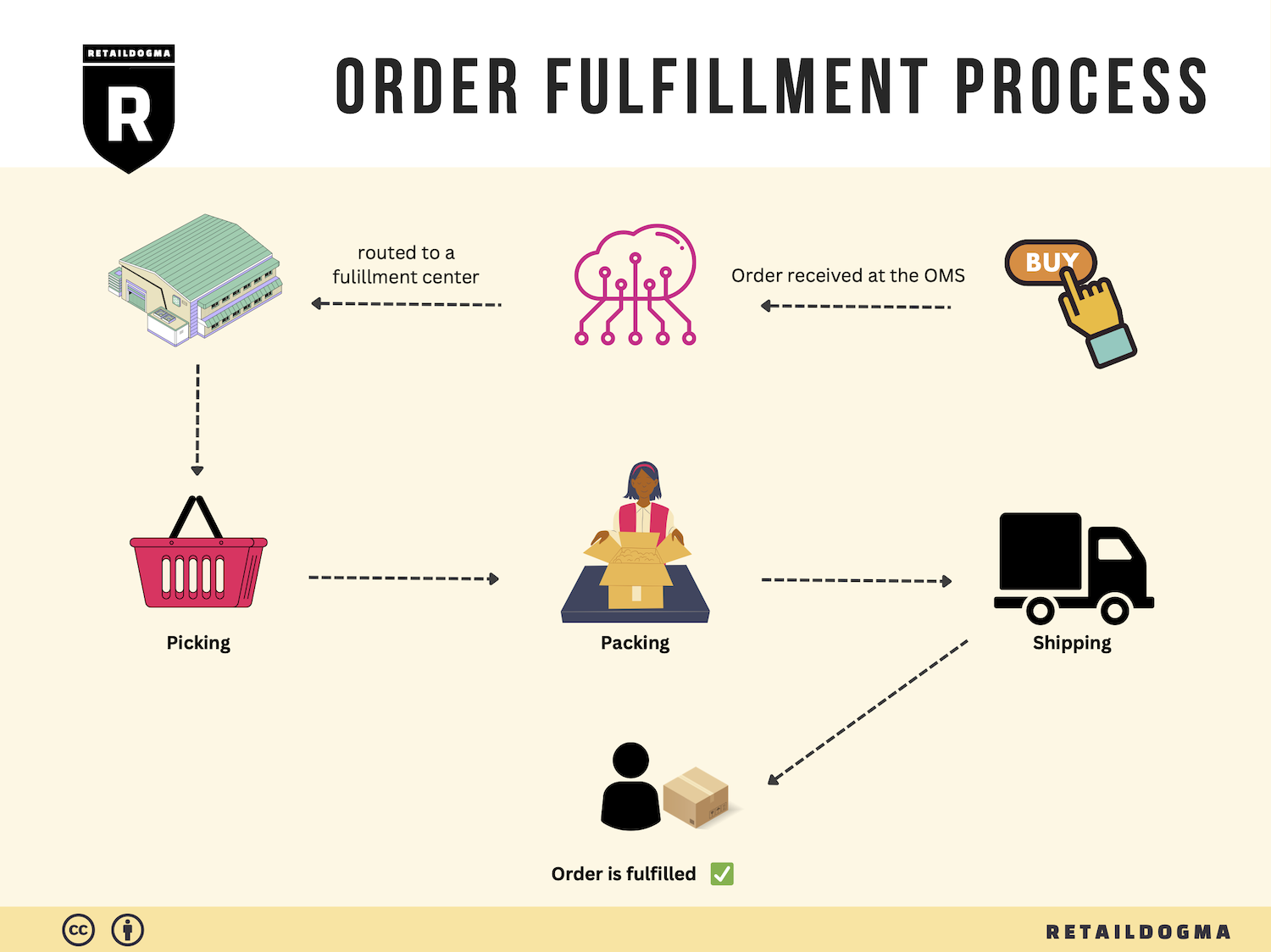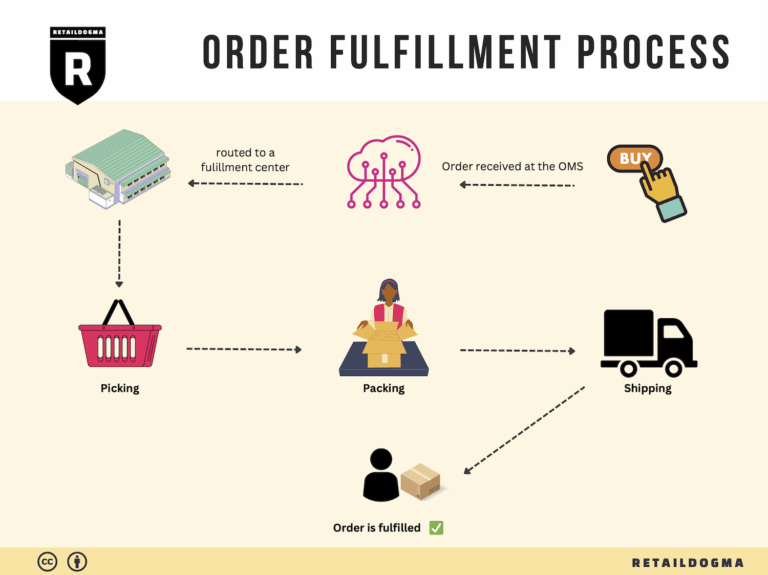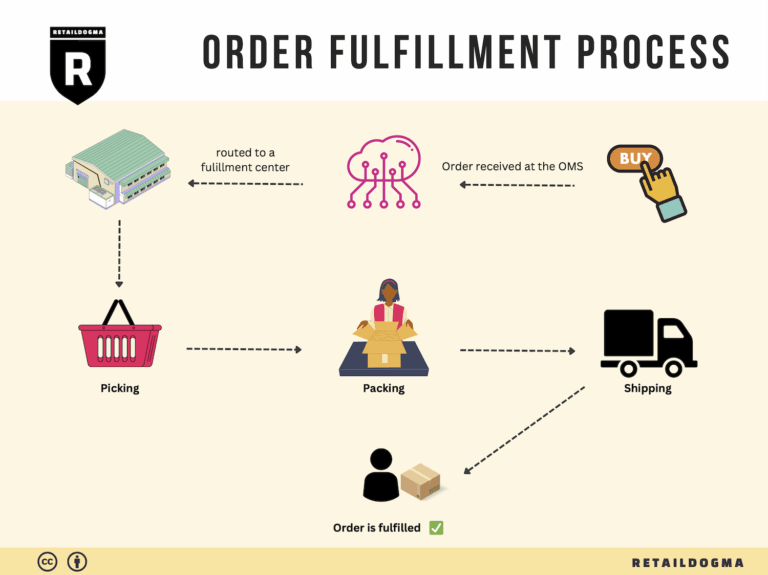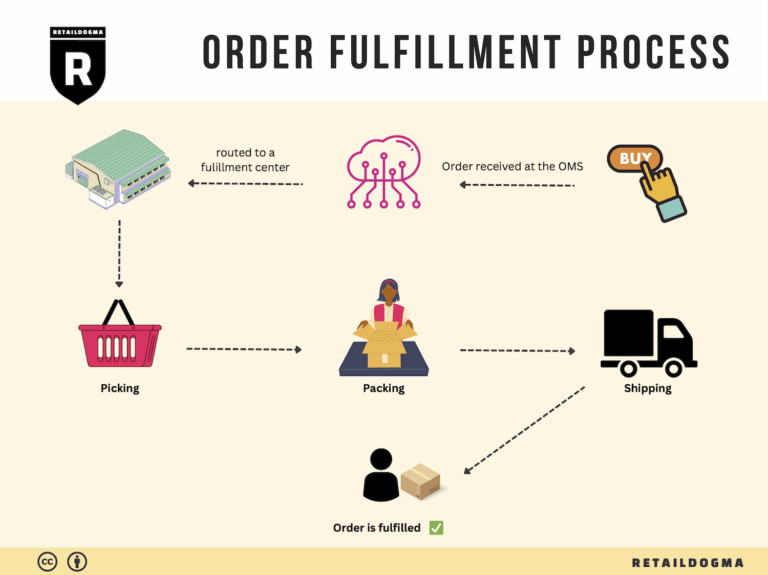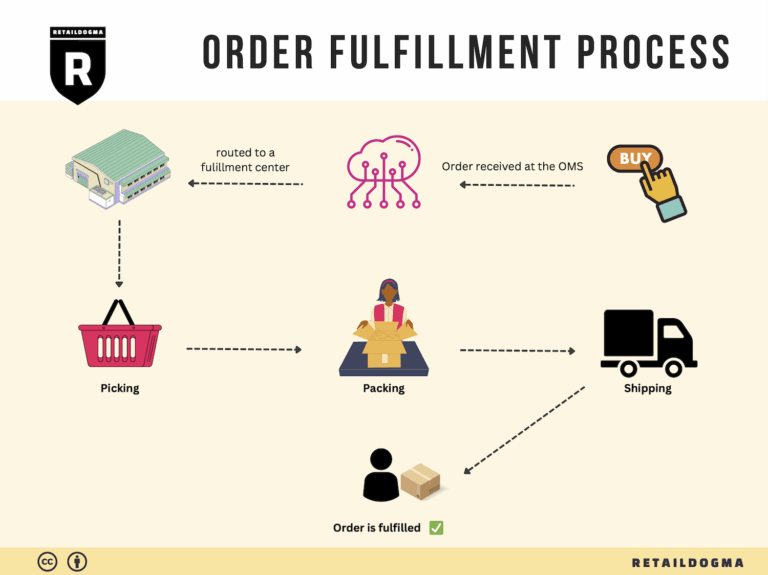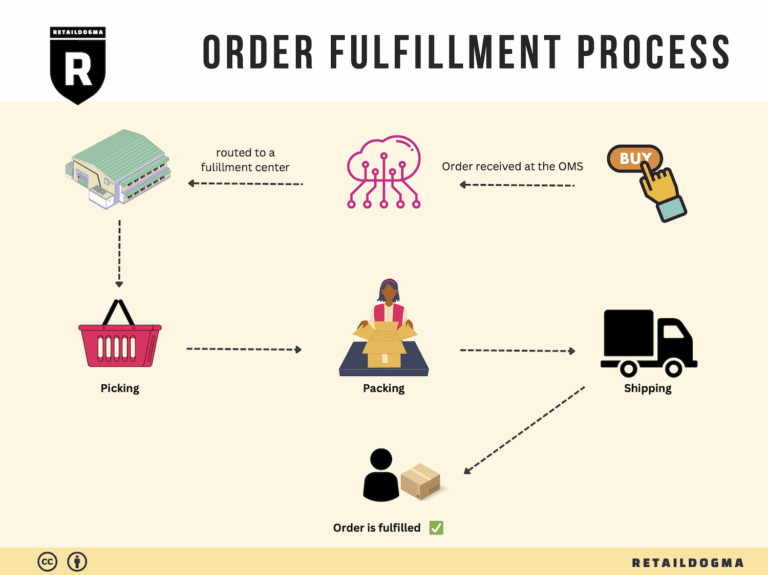How Order Fulfillment Works: A Step-by-Step Guide for Businesses
What is E-commerce Fulfillment? An Introduction for Growing Businesses
Understanding the Challenges of E-commerce Fulfillment
As an e-commerce business owner, you may find yourself overwhelmed by the complexities of packing and shipping orders. What starts as an exciting journey of selling products can quickly turn into a logistical nightmare. Managing inventory, ensuring timely deliveries, and maintaining customer satisfaction can feel like an uphill battle, especially as your business scales. This is where effective e-commerce fulfillment comes into play.
E-commerce fulfillment is fundamentally the process of getting a product from your store to your customer’s doorstep. It encompasses everything from inventory management and order processing to packing and shipping. As your business grows, understanding and optimizing this process becomes critical not just for operational efficiency, but also for enhancing customer experience.
What This Guide Will Cover
In this guide, we will delve into various e-commerce fulfillment models, including popular options such as Third-Party Logistics (3PL) and Fulfillment by Amazon (FBA). Each model has its own set of advantages and can be tailored to fit different business needs. We will explore the core services that fulfillment partners typically offer, such as warehousing, order picking, packing, and shipping.
Choosing the right fulfillment partner can be daunting, but it is a crucial decision that can significantly impact your business’s growth trajectory. We will provide practical insights on how to evaluate potential partners based on key factors such as reliability, technology integration, and service offerings.
Additionally, pricing is always a concern for growing businesses. We will break down the cost structures associated with different fulfillment models, helping you understand what to expect and how to budget effectively.
Empowering Your Logistics Decisions
The ultimate goal of this guide is to empower you to make informed decisions about your logistics strategy. By understanding the intricacies of e-commerce fulfillment, you can streamline your operations, reduce overhead costs, and, most importantly, enhance customer satisfaction. With the right knowledge and tools, you can transform fulfillment from a painful process into a strategic advantage that propels your business forward.
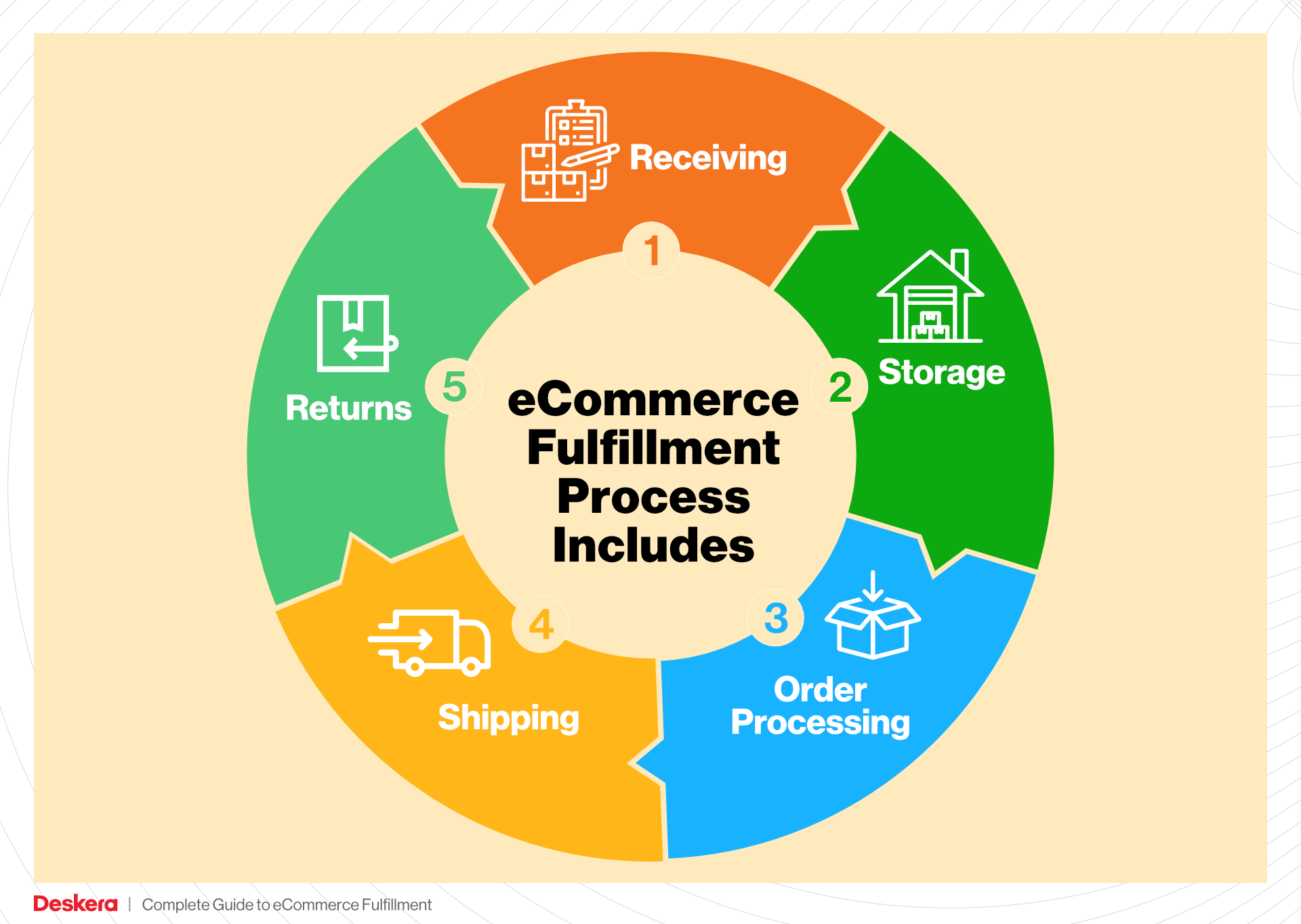
Let’s navigate the world of e-commerce fulfillment together, ensuring that you are well-equipped to meet the demands of your growing business.
What You’ll Learn In This Guide
- What is E-commerce Fulfillment? An Introduction for Growing Businesses
- The Order Fulfillment Process: From ‘Buy’ Button to Customer’s Door
- Comparing Fulfillment Models: In-House vs. 3PL vs. Dropshipping
- A Deep Dive into Amazon FBA: Pros, Cons, and Who It’s For
- Core Services Offered by Fulfillment Centers
- How to Choose a Fulfillment Partner: A 6-Point Checklist
- Understanding Fulfillment Pricing: A Breakdown of Common Fees
- Frequently Asked Questions (FAQs) about Fulfillment
- Conclusion: Is Outsourcing Fulfillment the Right Move for Your Business?
- Important Disclaimer
The Order Fulfillment Process: From ‘Buy’ Button to Customer’s Door
1. Receiving Inventory
The order fulfillment process begins with receiving inventory. When products arrive at the fulfillment center, they are unloaded and checked against the purchase order to ensure that the correct items and quantities have been delivered. This step is crucial for maintaining accurate stock levels and preventing discrepancies that can lead to stockouts or overstock situations.
During this process, each item is assigned a Stock Keeping Unit (SKU), a unique identifier that helps in tracking the product throughout the supply chain. Accurate receiving not only improves inventory accuracy but also sets the stage for efficient warehouse operations. Businesses must have robust receiving protocols in place, including quality checks, to ensure that damaged or incorrect items are identified and addressed immediately.
2. Warehouse Storage
Once the inventory is received and verified, it moves to warehouse storage. This stage involves organizing the products in a manner that maximizes space and facilitates easy retrieval. Proper storage strategies can significantly impact the efficiency of the entire fulfillment process.
Key considerations during this phase include the use of bin locations and inventory management systems. Bin locations help staff quickly locate items when orders come in, while inventory management systems provide real-time visibility into stock levels. Effective warehouse storage not only reduces retrieval times but also minimizes the chances of errors during order picking, ultimately enhancing customer satisfaction.
3. Order Picking
The next step is order picking, where items are selected from the warehouse to fulfill customer orders. This stage is critical, as it directly influences the accuracy and speed of order fulfillment. Efficient picking processes can lead to faster delivery times, which is a significant competitive advantage in the e-commerce landscape.
To streamline this process, many businesses utilize pick lists—documents that detail the items to be collected, their locations, and quantities. Implementing technology such as barcode scanners can also enhance accuracy and speed during picking. This step is vital because any mistakes made here can lead to incorrect shipments, resulting in returns, dissatisfied customers, and increased costs.
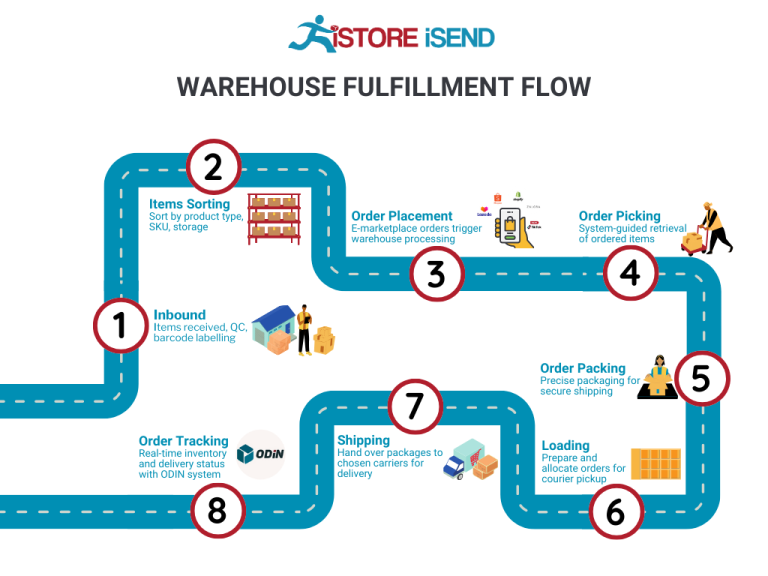
4. Order Packing
After the items have been picked, they proceed to the order packing stage. Proper packing is essential for protecting products during transit and ensuring that they arrive in perfect condition. This step not only involves placing items in appropriate packaging but also includes labeling and preparing them for shipment.
Key considerations during packing include the use of packing slips and shipping labels. Packing slips detail the contents of each package, while shipping labels provide the necessary information for delivery. Businesses must prioritize packing efficiency and accuracy, as well-packed orders contribute to reduced return rates and improved customer satisfaction.
5. Shipping & Delivery
The final step in the order fulfillment process is shipping and delivery. Once the orders are packed, they are handed over to shipping carriers for delivery to customers. This stage is crucial for ensuring that customers receive their orders promptly and as expected.
Key terms associated with this phase include tracking numbers and shipping methods. Tracking numbers allow customers to monitor their orders in real-time, enhancing transparency and trust. Additionally, selecting the right shipping methods is vital for balancing cost and speed. Businesses should analyze shipping options to find the most efficient routes and carriers, ensuring that they meet customer expectations while managing operational costs effectively.
Conclusion
Understanding and optimizing each step of the order fulfillment process is critical for e-commerce businesses aiming to scale. From receiving inventory to shipping and delivery, each stage plays a pivotal role in ensuring customer satisfaction and operational efficiency. By implementing best practices and utilizing the right tools, businesses can enhance their fulfillment processes and maintain a competitive edge in the market.
Comparing Fulfillment Models: In-House vs. 3PL vs. Dropshipping
Fulfillment Model Comparison
| Model | Who Handles Inventory | Best For (Business Stage) | Key Advantage | Key Disadvantage |
|---|---|---|---|---|
| In-House Fulfillment | The business itself | Startups to mid-sized firms | Complete control over inventory | High upfront costs and operational burden |
| Third-Party Logistics (3PL) | Third-party logistics provider | Growing to large businesses | Scalability and reduced overhead costs | Less control over inventory and operations |
| Dropshipping | Supplier/manufacturer | Startups and niche businesses | Low startup costs and minimal risk | Lower profit margins and reliance on suppliers |
In-House Fulfillment
In-house fulfillment involves managing the entire inventory and logistics process within your own facilities. This model is typically employed by startups and mid-sized companies that want to maintain complete control over their inventory and customer experience. The primary advantage of in-house fulfillment is that it allows businesses to customize their shipping processes, branding, and customer interactions. Companies can ensure that products are handled exactly as they wish and can adapt their operations quickly in response to changes in demand or customer preferences.
However, the in-house model comes with significant drawbacks. The initial setup costs can be high, requiring investment in warehouse space, inventory management systems, and hiring personnel. Additionally, the operational burden can be overwhelming as businesses scale, necessitating dedicated resources for managing logistics, order processing, and returns. As a result, while in-house fulfillment offers control, it also demands substantial time and financial resources, which can be a challenge for many growing businesses.
Third-Party Logistics (3PL)
Third-party logistics (3PL) involves outsourcing logistics and fulfillment operations to a specialized provider. This model is ideal for businesses that are growing or scaling up, as it allows them to leverage the expertise and infrastructure of established logistics companies. The key advantage of using a 3PL is scalability; businesses can adjust their logistics needs based on demand without the burden of managing warehouse space or logistics staff. This model also reduces overhead costs, as companies can avoid significant investments in inventory management systems and facilities.
On the downside, partnering with a 3PL can lead to reduced control over inventory and fulfillment processes. Businesses may find themselves reliant on the 3PL’s systems and capabilities, which can lead to inconsistencies in service quality if not managed effectively. Additionally, communication between the company and the 3PL is critical; any gaps in communication can result in fulfillment errors or delays, which can negatively impact customer satisfaction.
Dropshipping
Dropshipping is a fulfillment model where the retailer does not keep the products it sells in stock. Instead, when a store sells a product, it purchases the item from a third party and has it shipped directly to the customer. This model is particularly attractive to startups and niche businesses due to its low startup costs and minimal risk. Entrepreneurs can launch their e-commerce stores without the need for a significant upfront investment in inventory, allowing them to focus on marketing and customer acquisition.

However, dropshipping has its own set of challenges. The most notable disadvantage is the lower profit margins; since retailers rely on suppliers to fulfill orders, they often have to sell products at higher prices to maintain profitability. Additionally, dropshipping places a heavy reliance on suppliers for inventory quality and shipping times, which can lead to customer dissatisfaction if the supplier fails to meet expectations. As a result, while dropshipping provides a low-risk entry into e-commerce, it requires careful supplier selection and management to ensure a positive customer experience.
Conclusion
Choosing the right fulfillment model is crucial for e-commerce businesses aiming to scale efficiently. Each model—In-House Fulfillment, Third-Party Logistics (3PL), and Dropshipping—offers distinct advantages and disadvantages that can significantly impact operations, customer satisfaction, and overall profitability. Understanding these differences allows business owners to make informed decisions that align with their operational goals, growth stage, and market dynamics. By carefully considering their specific needs and resources, businesses can select a fulfillment model that not only supports their current operations but also positions them for sustainable growth in the competitive e-commerce landscape.
A Deep Dive into Amazon FBA: Pros, Cons, and Who It’s For
Understanding Fulfillment by Amazon (FBA)
Fulfillment by Amazon (FBA) is a service that allows e-commerce businesses to store their products in Amazon’s fulfillment centers. When a customer orders a product, Amazon takes care of storage, packaging, and shipping, as well as customer service and returns. This service has revolutionized the way many e-commerce businesses operate, providing a seamless logistics solution that can significantly enhance operational efficiency.
How FBA Works
-
Product Preparation and Shipping: Sellers prepare their products according to Amazon’s guidelines and ship them to one or more of Amazon’s fulfillment centers. Each center is strategically located to optimize shipping times and costs.
-
Storage: Once received, products are stored in Amazon’s warehouses. Sellers are charged for storage space, which is calculated based on the amount of space their products occupy.
-
Order Fulfillment: When a customer places an order, Amazon picks, packs, and ships the product on behalf of the seller. This process typically includes same-day handling for orders placed before a specific cut-off time.
-
Customer Service and Returns: Amazon also manages customer service inquiries and handles returns, making it easier for sellers to focus on growing their business rather than dealing with customer issues.
-
Reporting and Analytics: Sellers have access to detailed reports and analytics through their Amazon Seller Central accounts, allowing them to track inventory, sales, and customer feedback.
Pros of Amazon FBA
-
Prime Eligibility: Products fulfilled by Amazon are automatically eligible for Amazon Prime, which can significantly increase visibility and sales. Prime members often prefer products that can be shipped quickly, making FBA a powerful tool for capturing this customer segment.
-
Customer Trust: By using FBA, sellers can leverage Amazon’s reputation for reliability. Customers often feel more comfortable purchasing products that are fulfilled by Amazon, leading to higher conversion rates.
-
Multi-Channel Fulfillment: FBA can be used to fulfill orders from other sales channels, such as eBay or a seller’s own website. This flexibility allows sellers to centralize their inventory management and streamline operations across various platforms.
-
Scalability: FBA allows businesses to scale quickly. Sellers can expand their product offerings without worrying about logistics and fulfillment, as Amazon handles these aspects efficiently.
-
Inventory Management: Amazon provides tools for tracking inventory levels, helping sellers avoid stockouts and overstock situations. This can lead to better inventory turnover and improved cash flow.
-
Global Reach: With fulfillment centers located around the world, FBA enables sellers to reach international customers without the complexities of managing international shipping and customs.
Cons of Amazon FBA
-
High Fees: FBA comes with various fees, including storage fees, fulfillment fees, and additional costs for optional services. For some sellers, these costs can eat into profit margins, particularly for low-cost items.
-
Strict Inventory Rules: Amazon has stringent requirements regarding product preparation, labeling, and packaging. Failure to comply can lead to additional fees or even inventory being returned or disposed of.
-
Commingling Risks: With FBA, sellers’ inventory may be commingled with that of other sellers. This means that customers could receive a product from a different seller, which may lead to issues with product quality and brand reputation.
-
Loss of Control: By outsourcing fulfillment to Amazon, sellers may feel a loss of control over the customer experience. If a customer has a negative experience with shipping or packaging, it can reflect poorly on the seller, despite their lack of direct involvement.
-
Inventory Limits: Amazon imposes limits on the amount of inventory that can be stored in its fulfillment centers, especially for new sellers. This can restrict growth and the ability to stock up on popular items.
-
Long-Term Storage Fees: If inventory remains unsold for an extended period, sellers incur long-term storage fees, which can further erode profit margins.
Who is FBA Best For?
Fulfillment by Amazon is particularly suited for:
-
Small to Medium-Sized Businesses: Those looking to scale quickly without investing heavily in logistics infrastructure can benefit from FBA’s efficiency and reach.
-
Online Retailers with Seasonal Products: FBA allows sellers to handle peak seasons smoothly, such as holiday sales, without worrying about fulfillment logistics.
-
Brands Seeking Prime Customers: Sellers aiming to tap into the lucrative Prime member market can leverage FBA for increased visibility and sales.
-
Entrepreneurs Focused on Growth: Those who want to focus on product development, marketing, and customer engagement rather than logistics will find FBA to be a valuable ally.
-
Businesses with Global Aspirations: Sellers looking to reach international markets can utilize Amazon’s global fulfillment network to simplify the process.
In conclusion, while FBA offers numerous advantages such as Prime eligibility, customer trust, and ease of scaling, it is essential for sellers to weigh these against the potential downsides, including high fees and loss of control over fulfillment. Understanding these factors can help businesses make informed decisions about whether FBA is the right fit for their operations.
Core Services Offered by Fulfillment Centers
Inventory Management & Warehousing
Inventory management and warehousing are the foundation of effective fulfillment operations. Fulfillment centers provide businesses with the infrastructure to store their products securely and efficiently. This service typically includes tracking inventory levels, managing stock replenishment, and ensuring that products are organized and easy to access.
Benefits:
- Reduced Overhead Costs: By utilizing a fulfillment center, e-commerce businesses can avoid the costs associated with maintaining their own warehouse space. This includes expenses like rent, utilities, and staffing.
- Scalability: As your business grows, so too can your storage capabilities. Fulfillment centers offer flexible space options, allowing you to scale your inventory without the hassle of moving to a larger facility.
- Advanced Technology: Most fulfillment centers invest in sophisticated inventory management systems that provide real-time data on stock levels, allowing businesses to make informed decisions and reduce the risk of stockouts or overstock situations.
Pick and Pack Services
Pick and pack services refer to the process of selecting items from inventory (picking) and packaging them for shipment (packing). Fulfillment centers streamline this process, ensuring that orders are fulfilled quickly and accurately.
Benefits:
- Efficiency: Fulfillment centers are designed to optimize the pick and pack process, using advanced systems and trained staff to minimize errors and speed up order processing times. This efficiency translates to faster delivery times for customers, enhancing the overall shopping experience.
- Accuracy: With specialized technology and trained personnel, fulfillment centers can significantly reduce picking errors. Accurate order fulfillment is critical for maintaining customer satisfaction and loyalty.
- Time Savings: By outsourcing pick and pack services, e-commerce businesses can focus on core activities such as marketing, product development, and customer service, rather than spending time on order fulfillment.
Kitting and Assembly
Kitting and assembly involve combining multiple products into a single package or assembling components to create a finished product. Fulfillment centers can manage this process, allowing businesses to offer bundled products or customized orders without the need for in-house assembly lines.
Benefits:
- Enhanced Product Offerings: Kitting allows businesses to create unique product bundles that can attract more customers and increase sales. For example, a beauty retailer could offer a skincare kit that includes several complementary products.
- Reduced Complexity: By outsourcing kitting and assembly to a fulfillment center, businesses can simplify their operations. This reduces the need for in-house labor and the complexities associated with managing multiple SKUs.
- Cost Efficiency: Fulfillment centers often have the resources and expertise to perform kitting and assembly more cost-effectively than individual businesses could manage on their own. This can lead to lower production costs and increased profit margins.
Returns Management (Reverse Logistics)
Returns management, or reverse logistics, is the process of handling returned items from customers. Fulfillment centers play a crucial role in managing returns efficiently, ensuring that the process is seamless for both the business and the customer.
Benefits:
- Streamlined Process: Fulfillment centers have established procedures for processing returns, which can include inspecting items, restocking inventory, and managing refunds or exchanges. This streamlining reduces the burden on e-commerce businesses and enhances customer satisfaction.
- Data Insights: Analyzing return data can provide valuable insights into customer behavior and product performance. Fulfillment centers can assist businesses in identifying trends, allowing them to make informed decisions about inventory and product offerings.
- Improved Customer Experience: A hassle-free returns process can significantly enhance the customer experience. By leveraging the expertise of fulfillment centers, businesses can ensure that returns are handled quickly and efficiently, fostering customer loyalty and repeat purchases.
In summary, partnering with a fulfillment center provides e-commerce businesses with essential services that can enhance operational efficiency, reduce costs, and improve customer satisfaction. Whether it’s through effective inventory management, streamlined pick and pack services, kitting and assembly capabilities, or robust returns management, fulfillment centers are integral to scaling e-commerce operations.
How to Choose a Fulfillment Partner: A 6-Point Checklist
Location & Warehouse Network
Choosing a fulfillment partner with strategically located warehouses is critical for efficient logistics and timely delivery. A well-distributed network can significantly reduce shipping times and costs, which is essential for maintaining customer satisfaction in e-commerce.
Questions to Ask:
– What are the locations of your fulfillment centers, and how do they align with my target markets?
– How do you determine the best warehouse for shipping my products?
– Can you provide insights into your shipping times to various regions?
Technology & Integrations
In today’s digital age, the technology stack of a fulfillment partner is a key differentiator. The right tools can streamline operations, enhance inventory management, and improve overall efficiency. Your fulfillment partner should offer robust integrations with your e-commerce platform, ensuring seamless data transfer and real-time visibility.
Questions to Ask:
– What technology do you use for inventory management and order processing?
– How do you integrate with major e-commerce platforms like Amazon, Shopify, or WooCommerce?
– Can you provide API access for custom integrations with my existing systems?
Specializations (e.g., cold storage, oversized items)
Different businesses have unique product requirements that may necessitate specialized fulfillment capabilities. If you sell perishable goods, oversized items, or products requiring special handling, it’s crucial to partner with a fulfillment center that has the appropriate infrastructure and expertise.
Questions to Ask:
– Do you have facilities that can handle my specific product types (e.g., refrigerated, hazardous materials, oversized)?
– What protocols do you follow for storing and handling specialized items?
– Can you provide case studies or references from businesses with similar product needs?
Scalability & Capacity
As your business grows, so will your fulfillment needs. Selecting a partner that can scale operations in line with your growth is essential. This includes not only warehouse space but also operational flexibility to handle fluctuating order volumes, especially during peak seasons.
Questions to Ask:
– How do you manage scaling operations during peak seasons or unexpected demand surges?
– What is your capacity in terms of storage and order fulfillment?
– Can you accommodate seasonal fluctuations in inventory and order volume?
Pricing and Contracts
Understanding the pricing structure and contract terms of your fulfillment partner is vital to ensure that you’re not only getting a fair deal but also avoiding hidden costs that can erode your margins. Transparency in pricing can help you project your logistics expenses accurately.
Questions to Ask:
– What is your pricing model (e.g., per order, per item, monthly fees)?
– Are there additional fees for services like returns processing, storage, or packaging?
– What are the terms of your contract, and how flexible are they if my needs change?
Customer Support & Reviews
The level of customer support provided by your fulfillment partner can significantly impact your business operations. A responsive support team can resolve issues quickly, which is crucial for maintaining your service levels. Additionally, researching reviews and testimonials can provide insights into the partner’s reliability and service quality.
Questions to Ask:
– What customer support options do you provide (e.g., phone, email, chat)?
– What is your average response time for support inquiries?
– Can you share customer testimonials or case studies that demonstrate your service quality?
Conclusion
Selecting the right fulfillment partner can be a game-changer for your e-commerce business. By carefully evaluating potential partners against this checklist, you can ensure that you choose a fulfillment solution that not only meets your current needs but also supports your long-term growth. With the right partner, you can enhance your operational efficiency, improve customer satisfaction, and ultimately drive your business success.
Understanding Fulfillment Pricing: A Breakdown of Common Fees
Initial Setup Fees
When you first engage with a fulfillment service, you may encounter initial setup fees. These are one-time charges that cover the costs associated with establishing your account and integrating your inventory into the fulfillment center’s systems. Setup fees can vary significantly based on the complexity of your operation. For example, if your business requires custom software integration or specialized training for staff, these costs will be higher. Generally, expect to pay anywhere from $50 to several hundred dollars for these initial fees.
Receiving Fees
Receiving fees are charged when the fulfillment center receives your inventory. This fee compensates for the labor and resources needed to unload, inspect, and process your goods into their warehouse. Receiving fees can be calculated per unit or per hour of labor, depending on the fulfillment provider’s pricing structure. Typically, you might see charges ranging from $0.20 to $2.00 per unit, or an hourly rate for handling larger shipments. To minimize these costs, consider consolidating shipments to reduce the number of receiving events.
Storage Fees (per pallet/bin)
Storage fees are recurring charges for keeping your inventory in the fulfillment center. These fees are usually calculated on a per pallet or per bin basis and can vary depending on the season and the type of products stored. For instance, standard rates might range from $10 to $30 per pallet per month, while bin storage could be charged at $2 to $5 per bin. It’s essential to monitor your inventory turnover to avoid incurring unnecessary storage fees, particularly during peak seasons when rates may increase.
Pick & Pack Fees (per item/order)
Pick and pack fees are incurred each time an order is processed. This fee covers the cost of selecting items from storage, packing them for shipment, and preparing them for delivery. Pick and pack fees can vary based on the complexity of the order—such as the number of items included or special packing requirements. Generally, these fees range from $1 to $5 per order, with additional charges for each item picked. Businesses can reduce these costs by optimizing their inventory management and minimizing the number of SKUs in an order.
Shipping Fees
Shipping fees are among the most variable costs in fulfillment pricing. They depend on multiple factors, including the size and weight of the package, the shipping method chosen (standard, expedited, etc.), and the destination. Fulfillment centers typically negotiate shipping rates with carriers, and these costs can be passed on to you. Expect shipping fees to range from a few dollars for lightweight packages to much higher amounts for heavier shipments. To manage shipping expenses effectively, consider using a fulfillment service that offers discounted rates or exploring multi-carrier shipping solutions.
Tips for Getting an Accurate Quote
-
Understand Your Needs: Clearly define your logistics requirements, including the volume of products, order frequency, and special handling needs. This will enable fulfillment providers to give you a tailored quote.
-
Request Detailed Pricing Breakdown: Ask for a comprehensive quote that includes all potential fees, such as setup, receiving, storage, pick & pack, and shipping. This transparency will help you avoid unexpected costs.
-
Negotiate Terms: Don’t hesitate to negotiate pricing, especially if you expect high volumes or long-term engagement. Many fulfillment centers are willing to offer discounts for larger commitments.
-
Evaluate Seasonal Changes: Be aware that fulfillment pricing can fluctuate based on seasonal demand. Inquire about any potential changes in fees during peak periods.
-
Consider Multiple Providers: Get quotes from multiple fulfillment centers to compare pricing and services. This will provide you with a better understanding of the market and help you make an informed decision.
By understanding these common fulfillment fees and how they are calculated, e-commerce business owners can better manage their logistics costs and make informed decisions to scale their operations effectively.
Frequently Asked Questions (FAQs) about Fulfillment
1. What are Amazon fulfillment locations, and how do they benefit my business?
Amazon fulfillment locations, or fulfillment centers, are warehouses where Amazon stores, picks, packs, and ships products on behalf of sellers. Utilizing these centers allows businesses to leverage Amazon’s extensive logistics network, providing faster shipping options to customers and reducing the burden of inventory management and order fulfillment.
2. How can I find Amazon fulfillment centers near me?
To locate Amazon fulfillment centers in your area, you can use Amazon’s official website or third-party logistics platforms that provide updated lists of fulfillment center locations. Additionally, tools like Google Maps can help you search for specific addresses or codes associated with fulfillment centers.
3. What’s the difference between a warehouse and a fulfillment center?
A warehouse primarily focuses on storing goods until they are needed, while a fulfillment center specializes in processing orders and shipping products to customers. Fulfillment centers are equipped with advanced technology and systems to streamline order processing, manage inventory, and ensure timely delivery.
4. What is a 3PL, and how does it relate to Amazon fulfillment?
A Third-Party Logistics (3PL) provider is a company that offers outsourced logistics services, including warehousing, fulfillment, and shipping. While Amazon operates its own fulfillment centers, some businesses choose to partner with 3PL providers for added flexibility, specialized services, or to reach markets outside of Amazon’s network.
5. How much do fulfillment services cost?
Fulfillment service costs can vary widely based on several factors, including storage fees, order processing fees, and shipping costs. For Amazon FBA, sellers typically incur fees based on the size and weight of their products, as well as monthly storage fees for inventory held at fulfillment centers. It’s essential to analyze these costs against your pricing strategy to maintain profitability.
6. What types of products can I send to Amazon fulfillment centers?
You can send a wide range of products to Amazon fulfillment centers, including non-perishable items, electronics, clothing, and household goods. However, certain restricted items, such as hazardous materials or products requiring special handling, may not be eligible for FBA. Always check Amazon’s guidelines for specific product restrictions.
7. How does Amazon handle returns from fulfillment centers?
Amazon has a streamlined process for handling returns through its fulfillment centers. When a customer initiates a return, Amazon manages the return logistics, including shipping the product back to the fulfillment center. Depending on the condition of the item, it may be restocked or disposed of according to Amazon’s return policies.
8. Can I use Amazon fulfillment for international shipping?
Yes, Amazon offers fulfillment services for international shipping through programs like Amazon Global Selling. By enrolling in these programs, sellers can reach customers in various countries while benefiting from Amazon’s logistics capabilities, including customs clearance and international shipping options.
9. What is the role of technology in Amazon fulfillment centers?
Technology plays a crucial role in the efficiency of Amazon fulfillment centers. Advanced systems, such as robotics, AI-driven inventory management, and automated sorting, help streamline operations, reduce human error, and improve order accuracy. This technological integration enables faster processing times and enhances the overall customer experience.
10. How can I prepare my products for shipment to an Amazon fulfillment center?
To prepare your products for shipment to an Amazon fulfillment center, ensure they meet Amazon’s packaging and labeling requirements. This includes using appropriate materials, properly labeling each item with barcodes, and following guidelines for weight and size limits. Proper preparation helps avoid delays and ensures smooth processing upon arrival at the fulfillment center.
Conclusion: Is Outsourcing Fulfillment the Right Move for Your Business?
Evaluating the Benefits of Outsourcing Fulfillment
Outsourcing fulfillment can be a transformative decision for e-commerce businesses looking to enhance efficiency and scale operations. By leveraging a fulfillment service, companies can save significant time and resources. This allows business owners and operations managers to focus on core activities such as product development and marketing, rather than getting bogged down in the complexities of storage, packing, and shipping.
Moreover, partnering with an established fulfillment provider offers unparalleled scalability. As your sales grow, these services can easily adapt to increased order volumes without requiring you to invest in additional infrastructure. This flexibility is crucial for businesses navigating seasonal fluctuations or unexpected surges in demand.
Expertise is another critical advantage of outsourcing. Fulfillment centers are equipped with advanced technology and seasoned professionals who understand the nuances of logistics. This not only enhances operational efficiency but also improves customer satisfaction through faster and more reliable shipping options.
However, the choice of the right fulfillment partner is paramount. A misaligned partner can lead to inefficiencies and hinder growth. Therefore, businesses must conduct thorough due diligence to ensure that their chosen provider aligns with their operational goals and customer expectations.
To determine if outsourcing fulfillment is the right move for your business, consider auditing your current shipping processes. Analyze your order fulfillment times, costs, and customer feedback. This assessment will provide valuable insights into whether a fulfillment partner could enhance your operations and facilitate growth.
Taking this proactive step can set the foundation for a more efficient, scalable, and customer-centric business model.
Important Disclaimer
⚠️ Important Disclaimer
The information in this guide is for educational purposes. Fulfillment services, pricing, and platform features change frequently. Always conduct your own due diligence and consult with providers directly before making business decisions.
